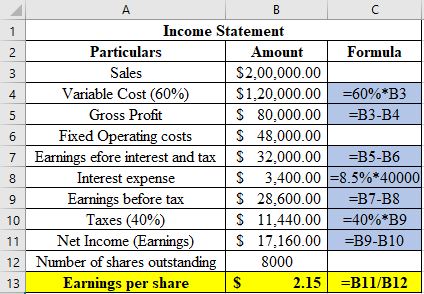
Concept explainers
Capital Structure of any company is the mix of different levels of debt and equity. An optimal capital structure is the appropriate mix of debt and equity, striking a balance between risk and return to achieve the goal of maximizing the price of the firm’s stock. Therefore, a target proportion of capital structure and cost of each financing can be used to determine the WACC of the company.
Weighted Average Cost of Capital (WACC) is the required
Here,
Proportion of debt in the target capital structure “
Proportion of preferred stock in the target capital structure “
Proportion of equity in the target capital structure “
After tax cost of debt, preferred stock,
EPS analysis at a given level of EBIT helps in determining the optimal capital structure of the firm, that is the structure at which the EPS will be the highest.
At a sale of $200,000 and debt to total asset ratio of 20%, the company has total assets $200,000, cost of debt 8.5% and number of shares outstanding 8,000.
Explanation of Solution
Income statement of the company is prepared with a debt of $40,000 (20%*$200,000) and interest rate on the debt of 8.5%.

Therefore, when D/TA is 20% and sales is $200,000, the company’s EPS would be
Want to see more full solutions like this?
- no ai do not answer this question if data is not clear or image is blurr. please comment i will write values . but do not amswer with unclear values. i will give unhelpful.arrow_forwardno ai Image is blurr do not answer this question if data is not clear or image is blurr. please comment i will write values but do not amswer with unclear values. i will give unhelpful sure.arrow_forwardDon't solve this question with unclear data. i will give unhelpful rating . please skip this qnarrow_forward
- The prodave paint company earned a net profit margin of 20% on revenues of $20m this year. Fixed Capital Investment was $2 m and depreciation was $3 m. Working capital Investment equals 7.5% of the Sales level in that year. Net income, fixed Capital Investment, depreciation, interest expenses and sales are expected to grow at 10% per year for the next 5 years. After 5 years, the growth in sales , net income, depreciation and interest expenses will decline to a stable 5% per year and fixed Capital Investment and depreciation will offset each other. The tax rate is 40% and the prodave has 1 m shares of common stock outstanding and long term debt paying 12.5% interest trading at it's par value of $32 m. The WACC is 17% during the high growth stage and 15% during the stable growth stage. Required: a) Calculate FCFE b) Determine FCFF c) Estimate the value of Equity d) Calculate the value of the Firmarrow_forwardA key dynamic within any Multi-National Corporation (MNC) is cash and foreign exchange risk exposure. Cash management is critical and also heavily influenced by global dynamics, especially since COVID-19. Within the Caribbean and North American jurisdiction, the economic framework is tightly connected with the major Asian economies of China, the United Kingdom and Japan. The Caribbean and the North American economy have been a barometer of the global economic cycle.) For both Caribbean and North American economies, many Multi-National Corporations have made significant investments to reduce the production cost of goods and diversification benefits. Despite the benefits that could materialize, some North American countries have not been resilient through Global market shocks. Given this context, the following questions require research within the Caribbean context and current market dynamics since COVID-19. Your Manager has asked you to address the following concerns in the report 1)…arrow_forwardA key dynamic within any Multi-National Corporation (MNC) is cash and foreign exchange risk exposure. Cash management is critical and also heavily influenced by global dynamics, especially since COVID-19. Within the Caribbean and North American jurisdiction, the economic framework is tightly connected with the major Asian economies of China, the United Kingdom and Japan. The Caribbean and the North American economy have been a barometer of the global economic cycle.) For both Caribbean and North American economies, many Multi-National Corporations have made significant investments to reduce the production cost of goods and diversification benefits. Despite the benefits that could materialize, some North American countries have not been resilient through Global market shocks. Given this context, the following questions require research within the Caribbean context and current market dynamics since COVID-19. Your Manager has asked you to address the following concerns in the report 1)…arrow_forward
- A key dynamic within any Multi-National Corporation (MNC) is cash and foreign exchange risk exposure. Cash management is critical and also heavily influenced by global dynamics, especially since COVID-19. Within the Caribbean and North American jurisdiction, the economic framework is tightly connected with the major Asian economies of China, the United Kingdom and Japan. The Caribbean and the North American economy have been a barometer of the global economic cycle.) For both Caribbean and North American economies, many Multi-National Corporations have made significant investments to reduce the production cost of goods and diversification benefits. Despite the benefits that could materialize, some North American countries have not been resilient through Global market shocks. Given this context, the following questions require research within the Caribbean context and current market dynamics since COVID-19. Your Manager has asked you to address the following concerns in the report 1)…arrow_forwardJeff Krause purchased 1,000 shares of a speculative stock in January for $1.89 per share. Six months later, he sold them for $9.95 per share. He uses an online broker that charges him $10.00 per trade. What was Jeff's annualized HPR on this investment? Jeff's annualized HPR on this investment is %. (Round to the nearest whole percent.)arrow_forwardCongratulations! Your portfolio returned 16.7% last year, 2.5% better than the market return of 14.2%. Your portfolio had a standard deviation of earnings equal to 18%, and the risk-free rate is equal to 4.4%. Calculate Sharpe's measure for your portfolio. If the market's Sharpe's measure is 0.29, did you do better or worse than the market from a risk/return perspective? The Sharpe's measure of your portfolio is (Round to two decimal places.)arrow_forward
- On January 1, 2020, Simon Love's portfolio of 15 common stocks had a market value of $258,000. At the end of May 2020, Simon sold one of the stocks, which had a beginning-of-year value of $26,900, for $31,400. He did not reinvest those or any other funds in the portfolio during the year. He received total dividends from stocks in his portfolio of $11,900 during the year. On December 31, 2020, Simon's portfolio had a market value of $246,000. Find the HPR on Simon's portfolio during the year ended December 31, 2020. (Measure the amount of withdrawn funds at their beginning-of-year value.) Simon's portfolio HPR during the year ended December 31, 2020, is %. (Round to two decimal places.)arrow_forwardChee Chew's portfolio has a beta of 1.27 and earned a return of 13.6% during the year just ended. The risk-free rate is currently 4.6%. The return on the market portfolio during the year just ended was 10.5%. a. Calculate Jensen's measure (Jensen's alpha) for Chee's portfolio for the year just ended. b. Compare the performance of Chee's portfolio found in part a to that of Carri Uhl's portfolio, which has a Jensen's measure of -0.25. Which portfolio performed better? Explain. c. Use your findings in part a to discuss the performance of Chee's portfolio during the period just ended.arrow_forwardDuring the year just ended, Anna Schultz's portfolio, which has a beta of 0.91, earned a return of 8.1%. The risk-free rate is currently 4.1%, and the return on the market portfolio during the year just ended was 9.4%. a. Calculate Treynor's measure for Anna's portfolio for the year just ended. b. Compare the performance of Anna's portfolio found in part a to that of Stacey Quant's portfolio, which has a Treynor's measure of 1.39%. Which portfolio performed better? Explain. c. Calculate Treynor's measure for the market portfolio for the year just ended. d. Use your findings in parts a and c to discuss the performance of Anna's portfolio relative to the market during the year just ended.arrow_forward
 Managerial Accounting: The Cornerstone of Busines...AccountingISBN:9781337115773Author:Maryanne M. Mowen, Don R. Hansen, Dan L. HeitgerPublisher:Cengage Learning
Managerial Accounting: The Cornerstone of Busines...AccountingISBN:9781337115773Author:Maryanne M. Mowen, Don R. Hansen, Dan L. HeitgerPublisher:Cengage Learning
